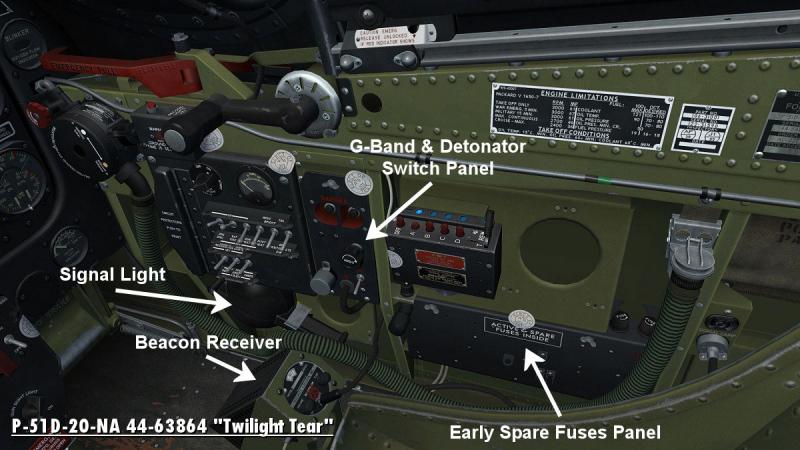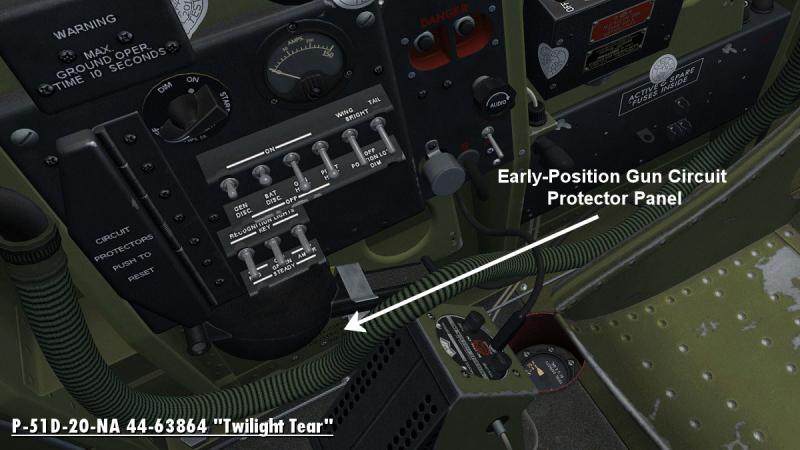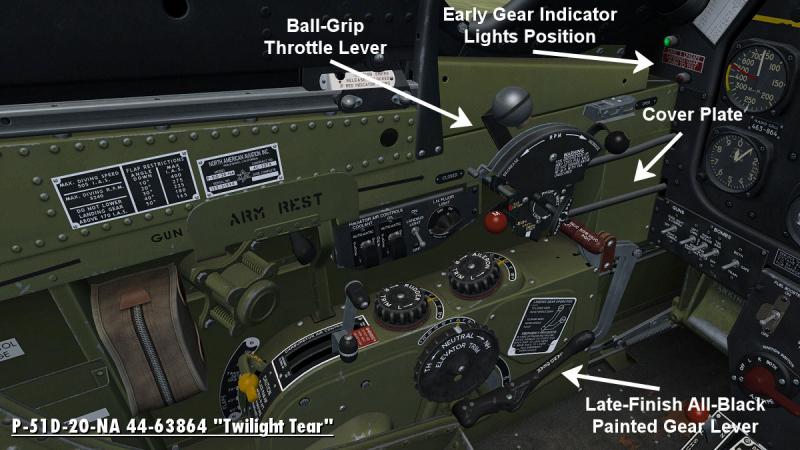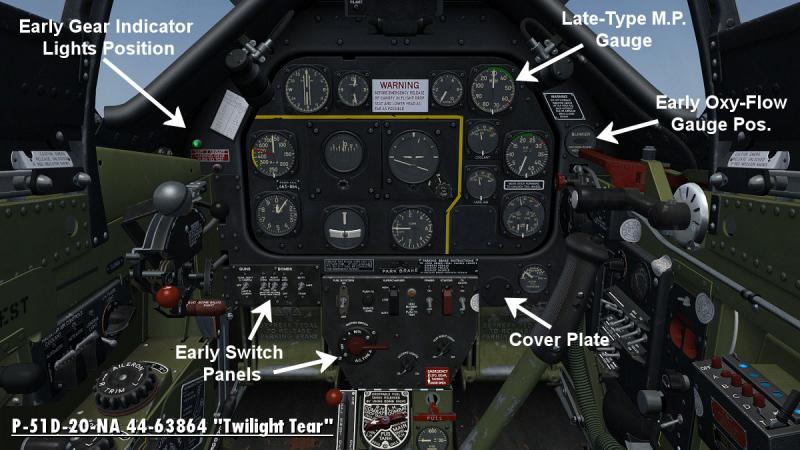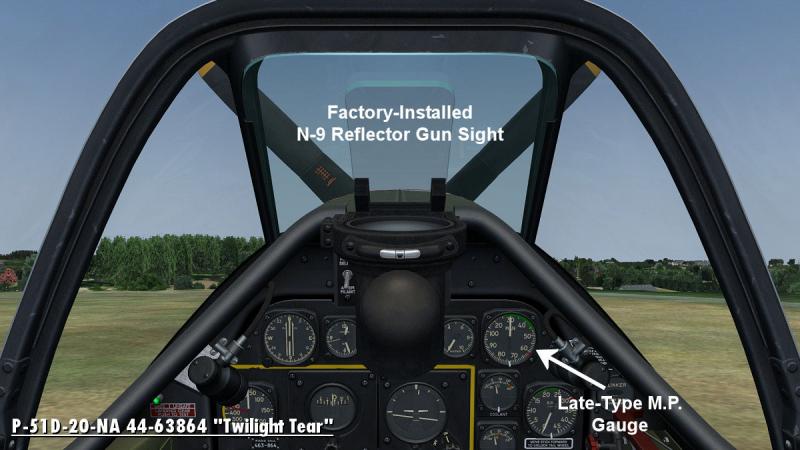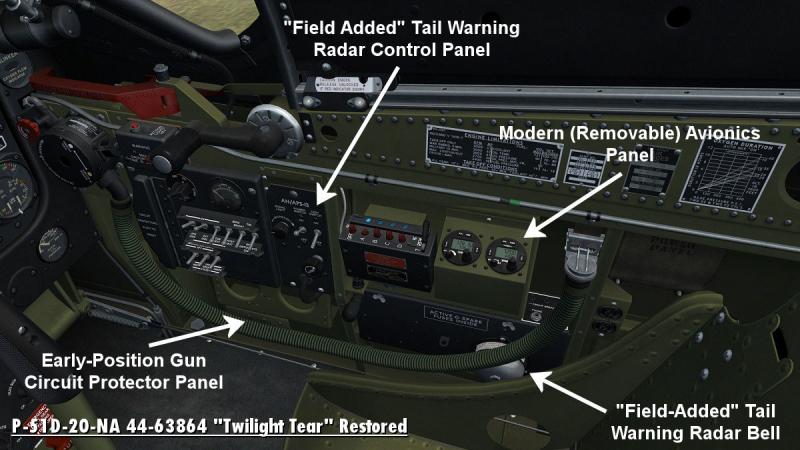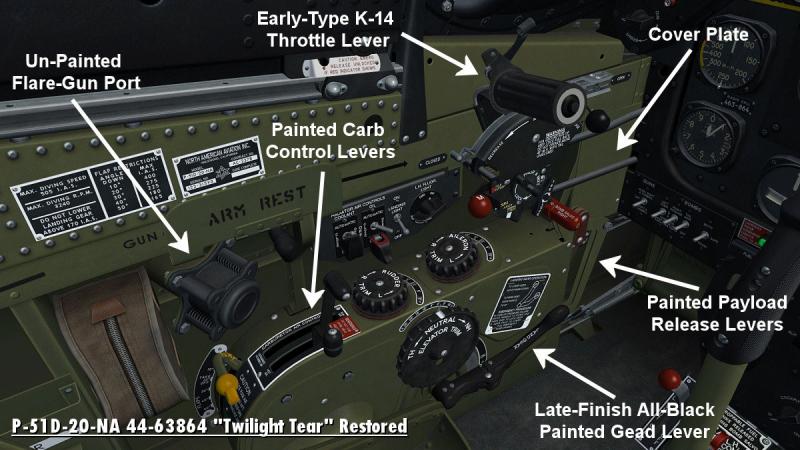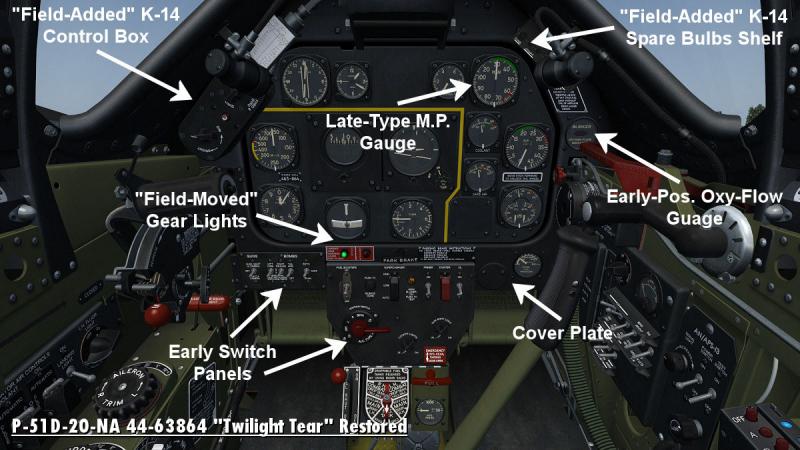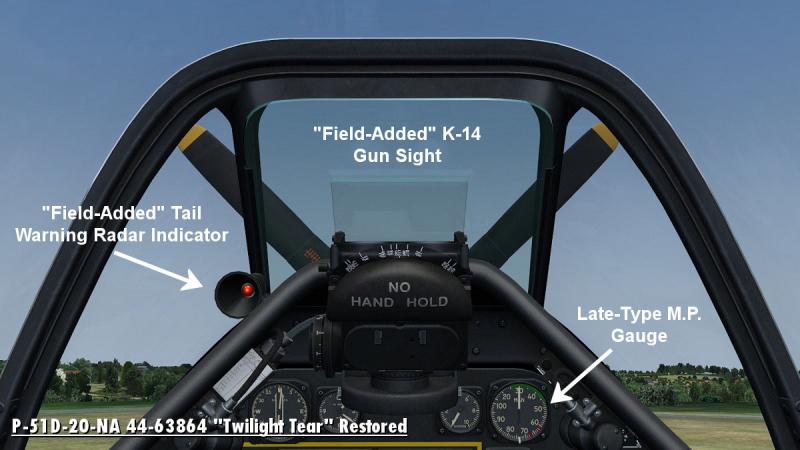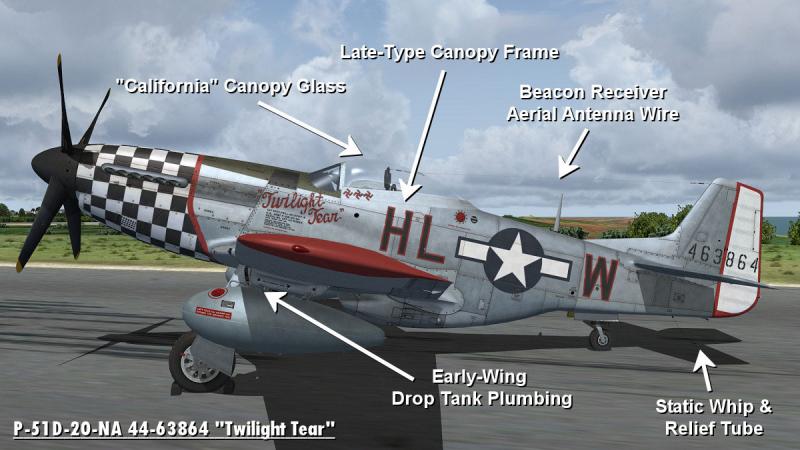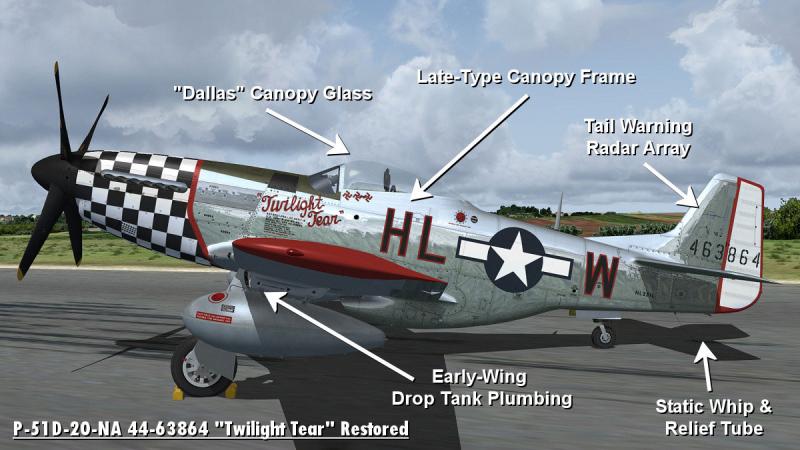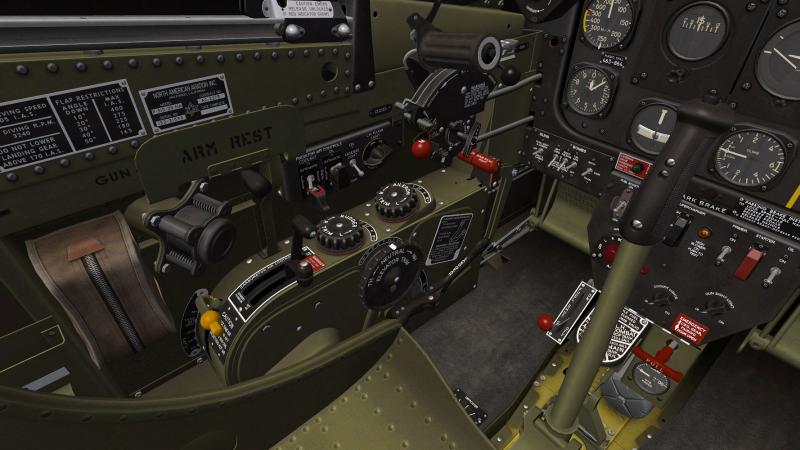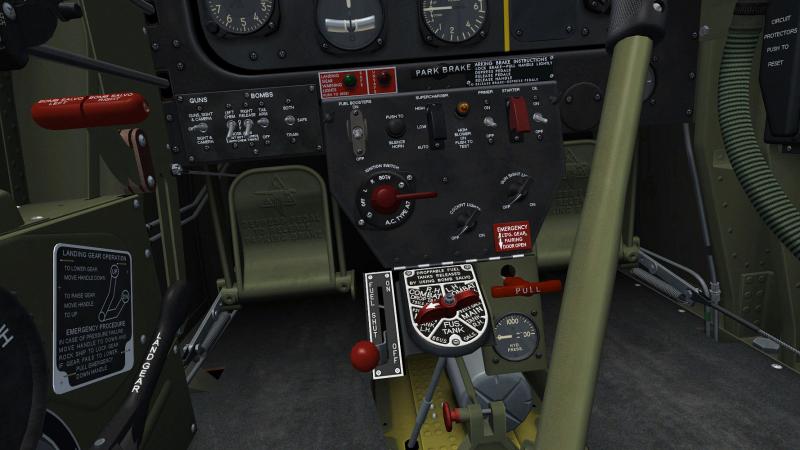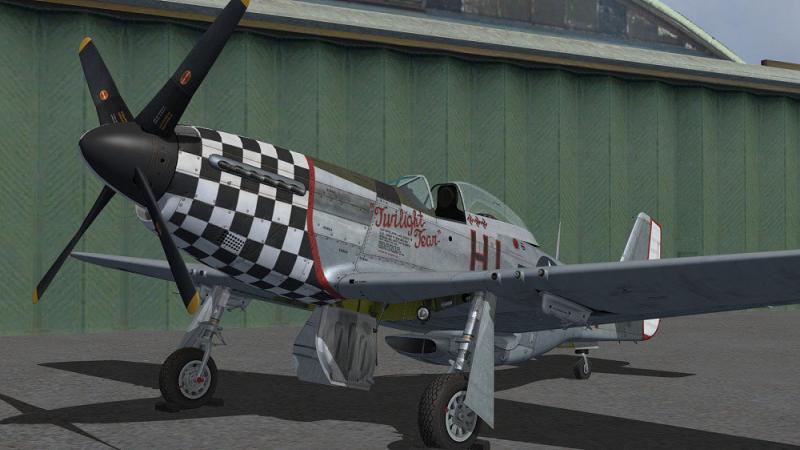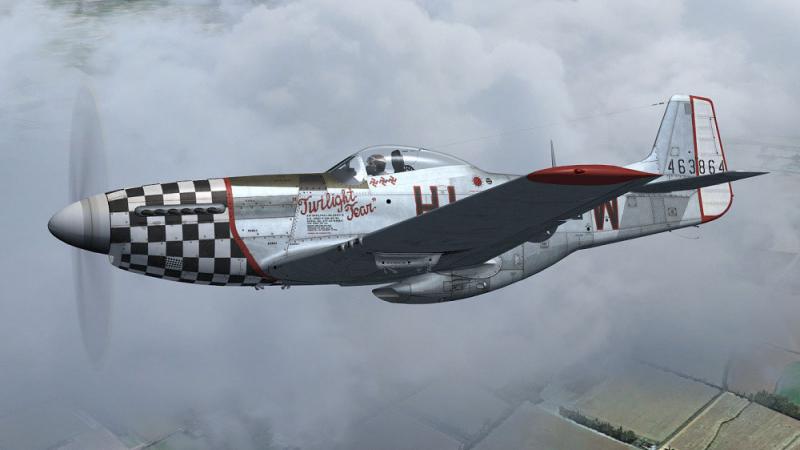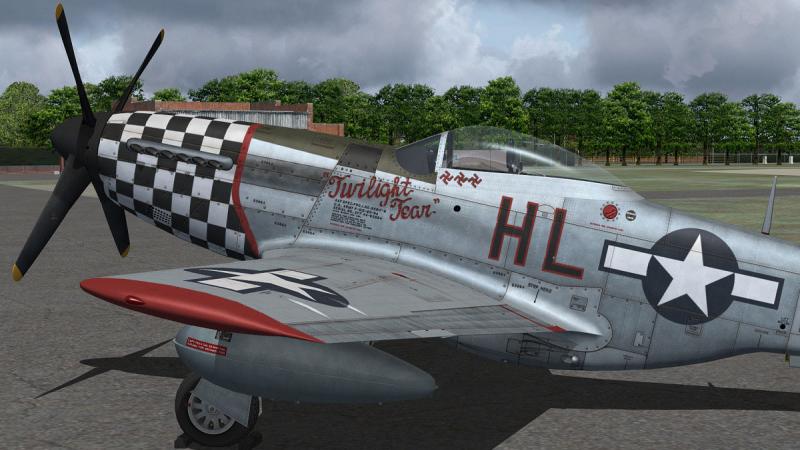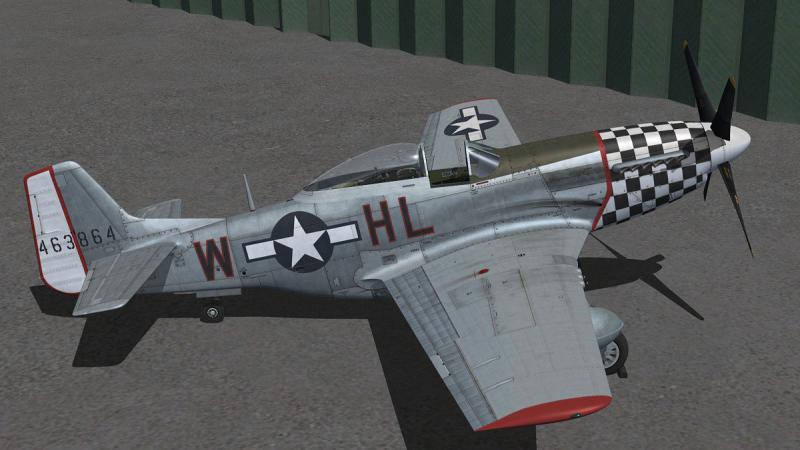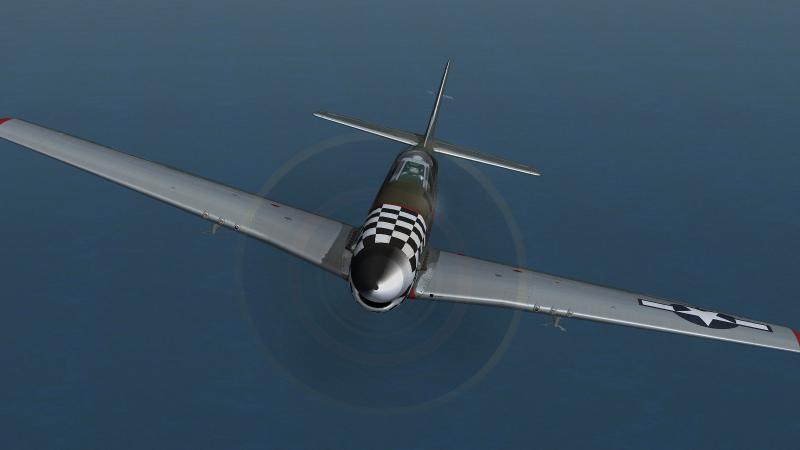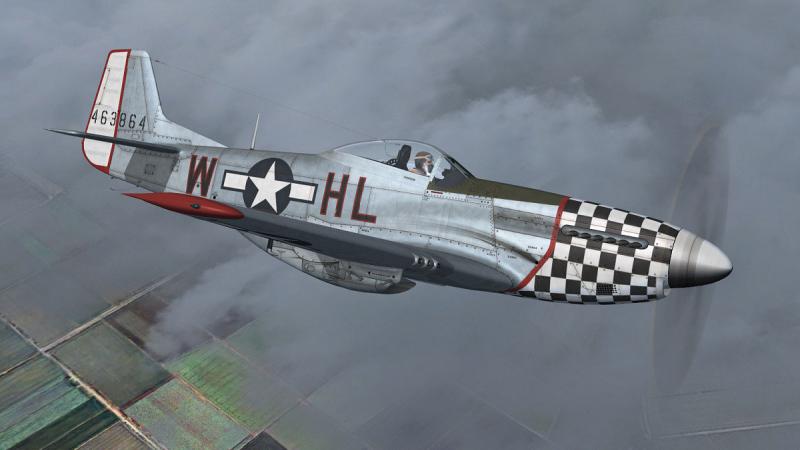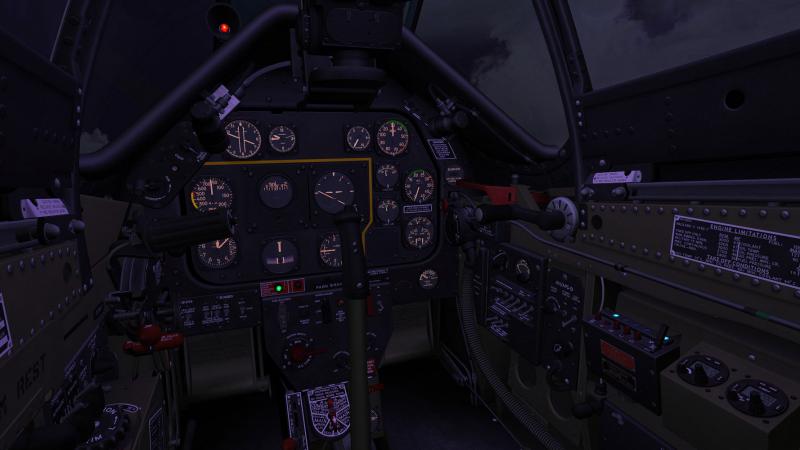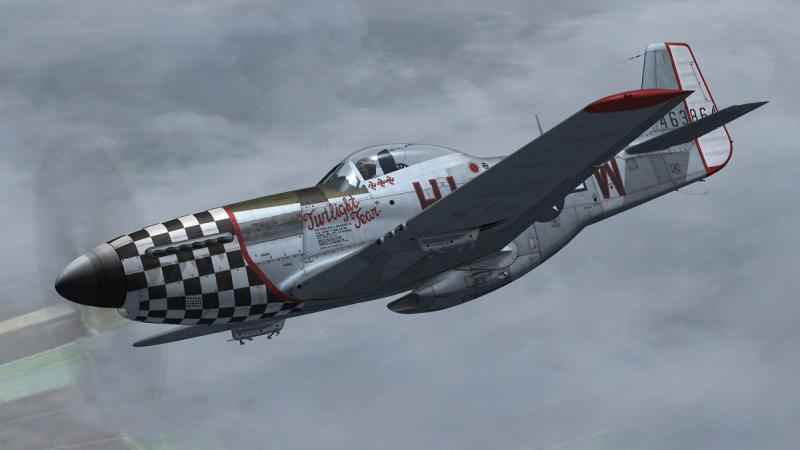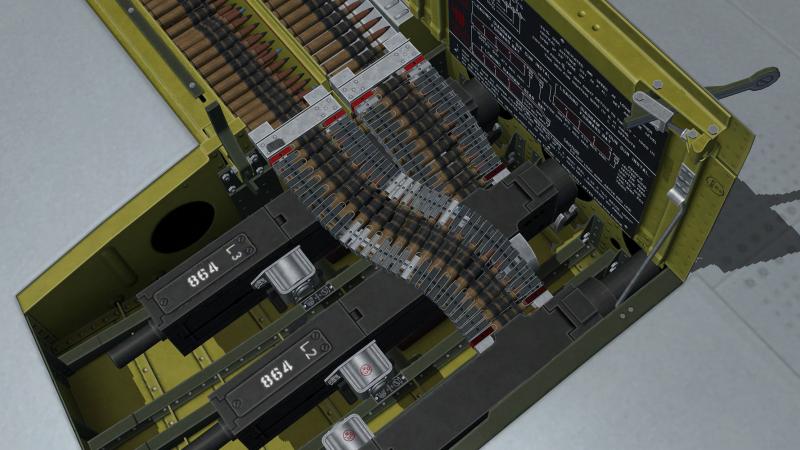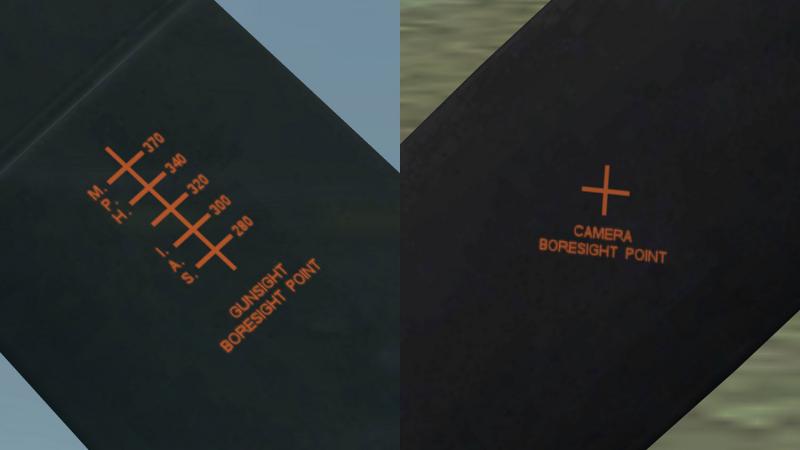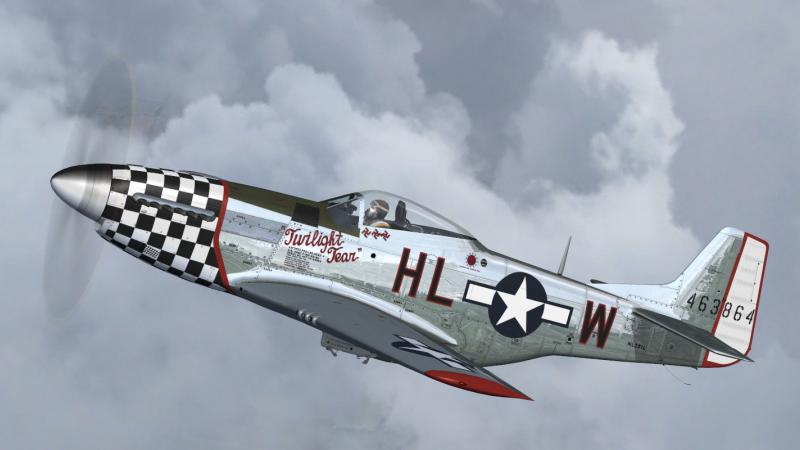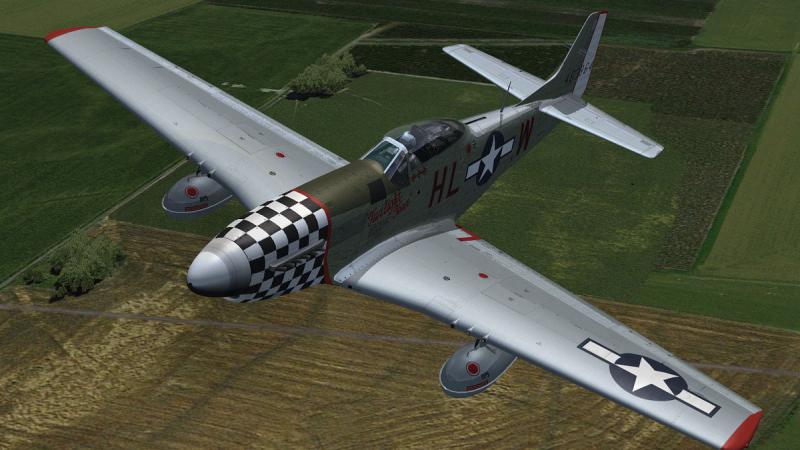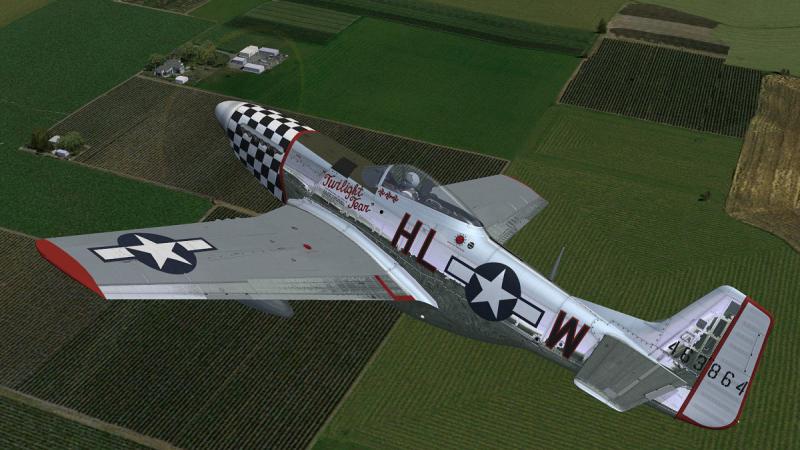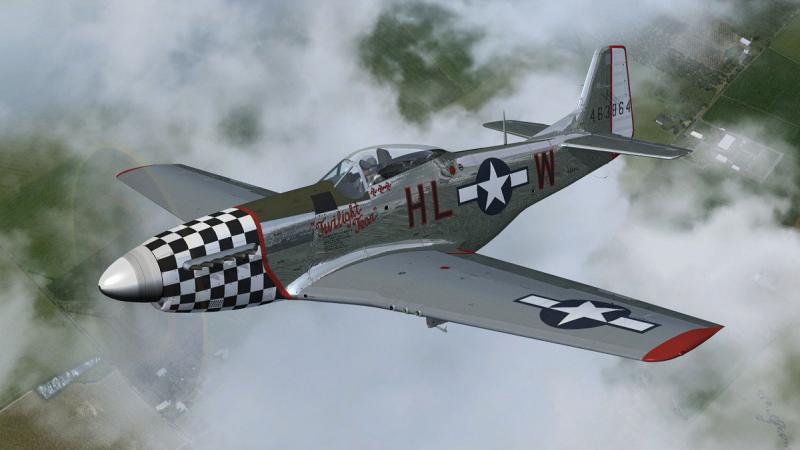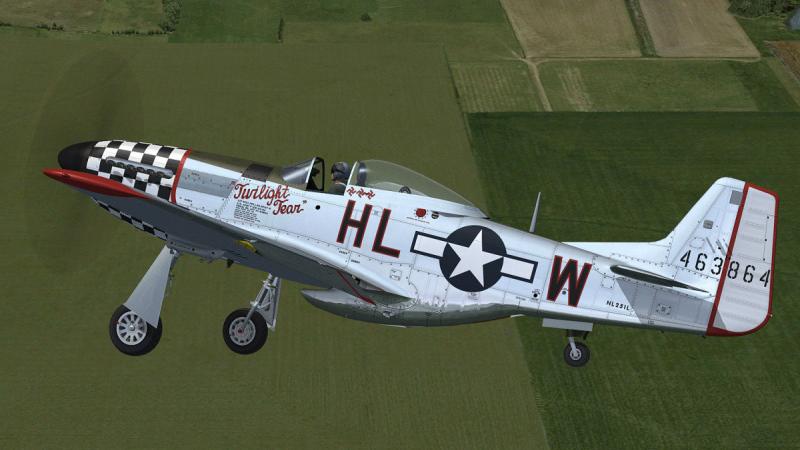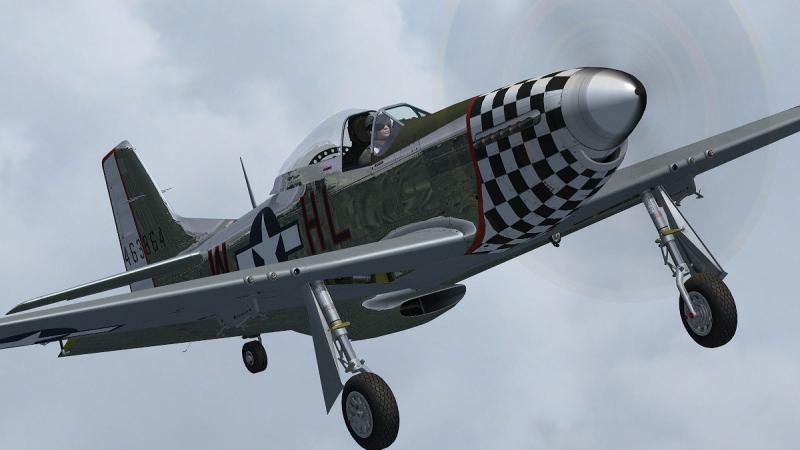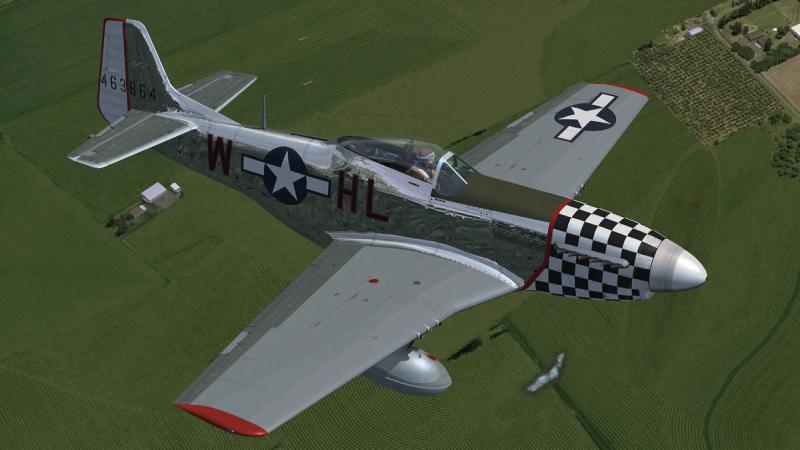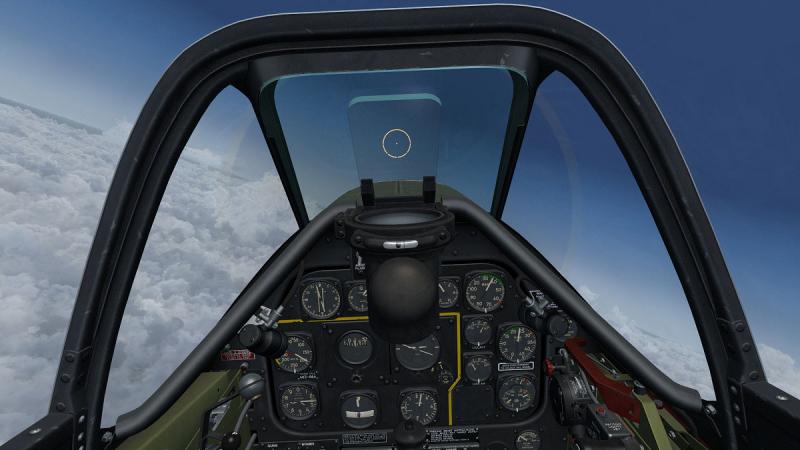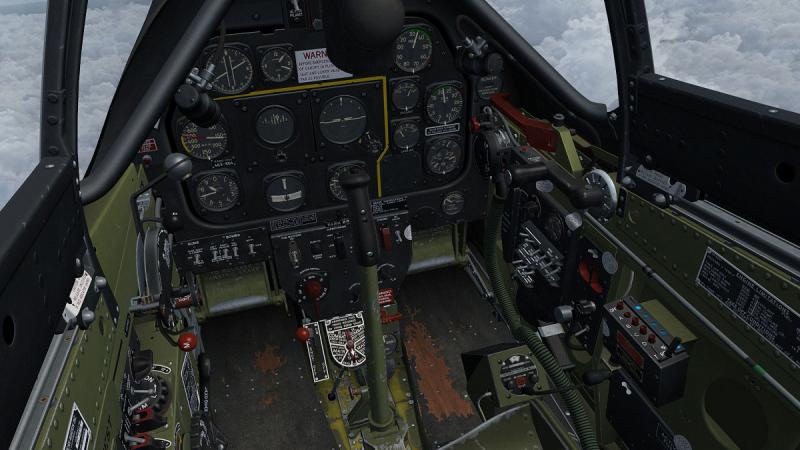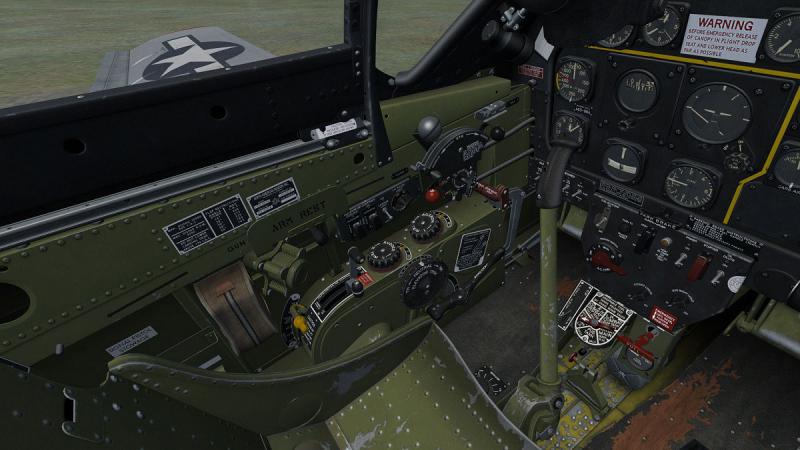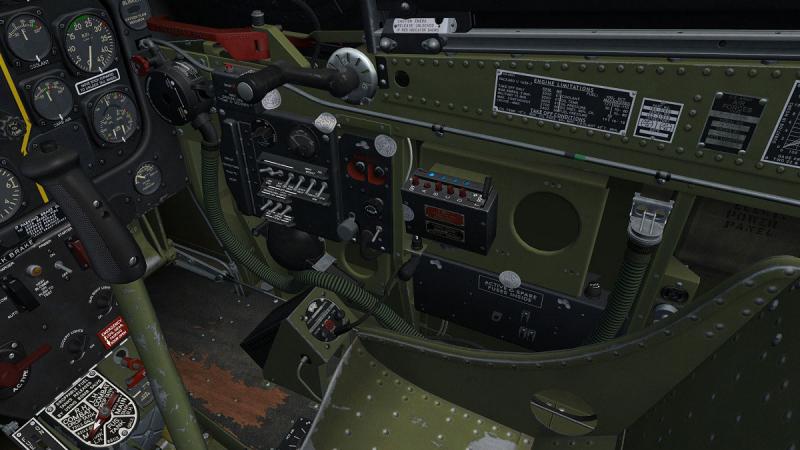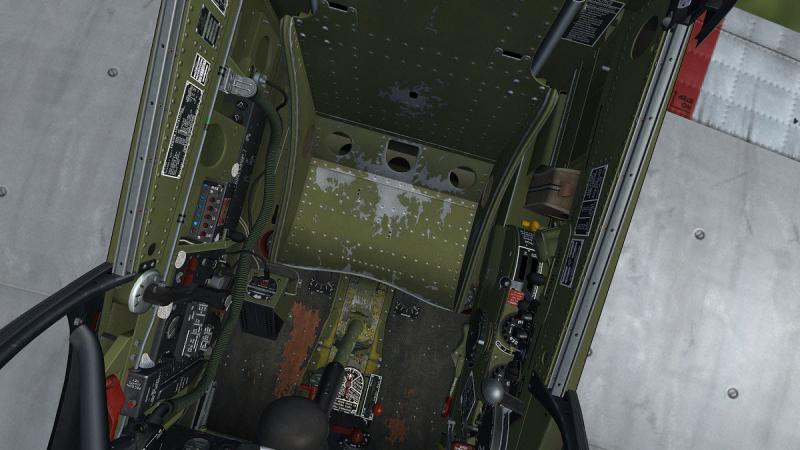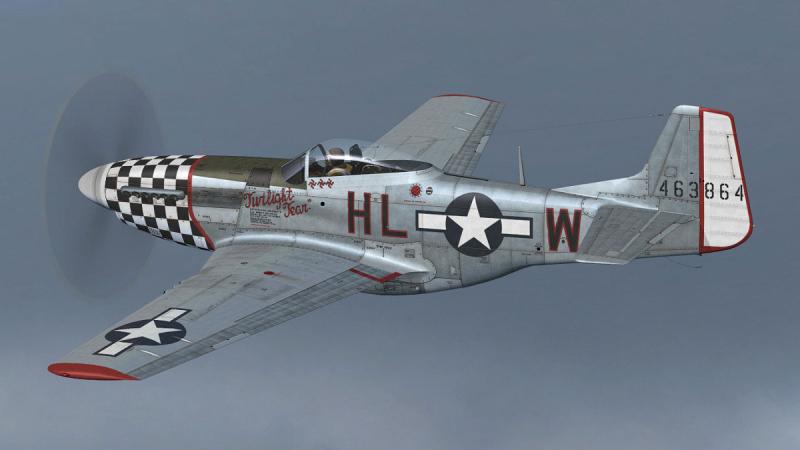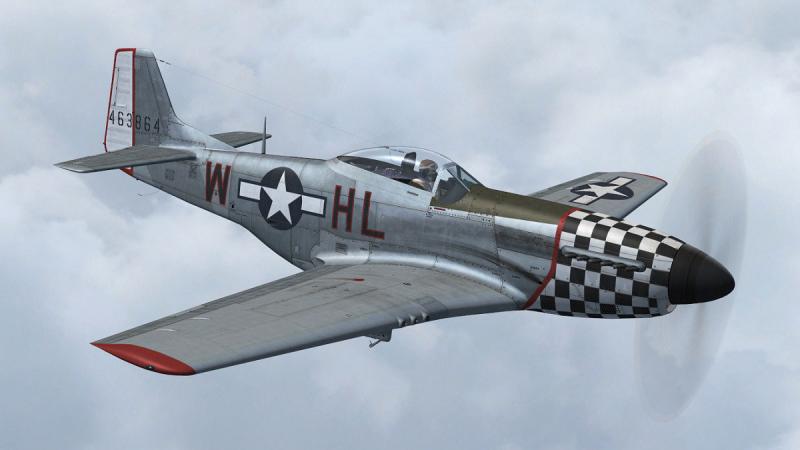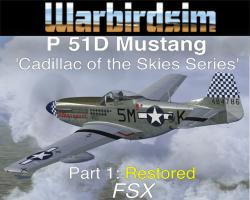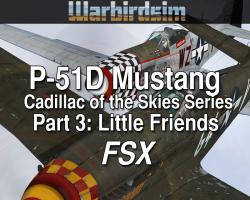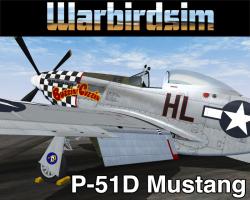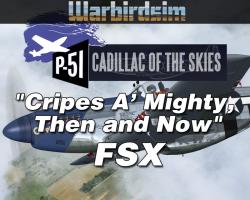"Twilight Tear, Then and Now": The P-51D Mustang Cadillac of the Skies Series for FSX
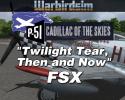
North American's Classic Iconic the P-51D takes to the skies with Part 6 of our unique series of sets specially designed for FSX featuring THE most accurate modeling and performance of this iconic aircraft ever made for simulation bar none! Read more...
- Media Format
- Immediate Download
- Compatibility
- Microsoft Flight Simulator X SP2 / Acceleration
- File size
- 146.5 MB
- Developer
- Warbirdsim
CALLING ALL PROFESSIONAL AIRMEN: Take a look at the long list of details below and (following recent testing) see why our versions are already being hailed by REAL Mustang pilots and Museums as "the most accurate version of the P51 flying in any simulation today"
Warbirdsim is proud to introduce P-51D "Twilight Tear, Then and Now. the personal mount of Lt. Hubert "Bill" Davis. From the wear and tear of combat, to the polish and perfection of an outstanding restoration, this product features fully authentic reproductions of Twilight Tear as it would have been seen in late 1944 and 1945 as well as the aircraft as it is restored today as an EAA Grand Champion award Warbird . This product provides for a level of accuracy in reproducing these particular aircraft that has never been made possible before. Whether you are interested in re-living the past, or recreating the present, available now is both the chance to fly the P-51D as Lt. Davis would have known it in 1945, or as current pilots will find it in the meticulous restoration of today."
Using ORIGINAL North American plans and blueprints and working from literally thousands of photographs and sketches incorporating three years of extensive research and development. This is THE enthusiasts definitive version that many have long been waiting for brought to life with all the loving care and stunning attention to detail our studios are becoming renowned for.
This P-51D, an early-production P-51D-20-NA, is quite unique in that it is one of a very select few surviving Mustangs that actually saw combat use in WWII. 44-63864 was built early enough in the war, that upon arrival to England it was assigned to the 78th FG 83rd FS at Duxford. From there, the aircraft became the personal mount of Lt. Hubert "Bill" Davis. Lt. Hubert named the aircraft after the "1944 Race Horse of the Year", a filly named Twilight Tear. The aircraft was credited with shooting down three enemey aircraft - 1 Me-109 on March 2nd, 1945, and 2 Me-109's on March 19th, 1945 (67-years ago today!). Following the end of WWII, the aircraft, which remained in Europe, was sold to Sweden, where it became RSwAF Fv26158 F16 coded Red D, and later Green K. Following service in the Swedish AF, the aircraft was obtained by the Israeli AF. The aircraft was then later sold to William Lear Jr. who flew it from Tel Aviv to Athens, and then to Geneva, with the aircraft registered then as N251L in 1960. In the summer of 1963, the aircraft was to be ferried accross the Atlantic to the U.S., by pilot Roger Gaston Arnoult, but Arnoult, having never flown a P-51 before, crashed on landing at Reykjavik, Iceland. The aircraft was almost sold for scrap, but the remains were rescued by Petur Jonsson and Michael Valdimarsson in 1986. The remains were then purchased by Ron Fagen, of Granite Falls, MN, who sent the project to Tri State Aviation for a rebuild to completely stock and airworthy condition. The aircraft flew again for the first time since 1963, in April of 2011. Final detailing was conducted through a joint-effort by Fagen's Warhawks Inc. restoration company, and the then newly founded Aircorps Aviation restoration company. The aircraft was then showcased at the 2011 EAA Oshkosh Airventure air show, where it won the WWII Grand Champion award for the authenticity and complexity of the restoration.
"Two Twilight Tears"
Of note, is the fact that this isn't the same airframe painted as Twilight Tear and formerly owned by The Fighter Collection, based at Duxford a few years ago. Through a mistaken identity-connection, that airframe was indeed believed to have been the original "Twilight Tear", but that was due to a, paperwork issue from its time in Israel (it seems all P-51's that entered into the Israeli AF ended up having their serial numbers shuffled around and re-assigned - one other case in-point also being, that the airframe used in the "Galloping Ghost" owned by Jimmy Leeward, that came out of Israel, was almost certainly not the same airframe as the original "Galloping Ghost" of the 40's that went into Israel, for this very same reason (despite the Israeli paperwork claiming that it was the same airframe). Even though the name "Lt. Bert Lee" and two Japanese flags were found etched into the metal of the TFC Mustang, the same metal the Mustang was originally produced with in 1944 and never removed, not much thought was given to it at the time that all of the belief was around that it was the wartime "Twilight Tear". However, by about 2006/2007, with the owner of the wreckage removed from Iceland, being able to prove absolutely that it was in fact the original 44-46863, and photographic evidence showing the wartime Pacific-based P-51K-10-NT "Fragile But Agile" with the exact name "Lt. Bert Lee", as well as the same two Japanese flags, painted on the aircraft in the exact same spots, it became clear that the former TFC Mustang, which had now switched owners, was actually the wartime Pacific-Theatre vet, and by 2010 the aircraft was fully restored and painted in the markings it really did once have during WWII.
Looking around the cockpits of the two versions of the aircraft, one can see how the same basic core remained, though a number of features changed. For instance, not only was the N-9 sight removed, and the K-14 sight added, but due to the location of the K-14 gunsight control box, the landing light indicators also had to move, as did the compass correction card. The re-positioning of these items are actually illustrated and instructed through the technical order documents for the in-field installation of the K-14. With the change in gunsight, also came a change in throttle lever. With the installation of the AN/APS-13 tail warning radar set, the previous G-Band, radio audio, and radio detonation switch panel was replaced with the panel designed for use with the radar set, featuring the controls for activiating and using the tail warning radar, and the radio detonation and G-Band controls were deleted as a result. The indicator for the tail warning radar was mounted to the top left-side of the instrument panel shroud (standard position), and the warning bell was mounted to the radio fuse and circuit panel on the lower right-hand side of the cockpit.
Note that there is a circular cover plate on the lower right-hand side of the instument panel. The reason for this, is that the panel was initially designed for use with the manual primer pump, as seen in the P-51D-5-NA, but by the time of the P-51D-15-NA, the manual pump was deleted and an electrical primer was added, with a toggle switch added to the center electrical panel. Despite this, the panel was changed right away to support this, so the panel continued to be manufactured with the main hole and mounting holes manufactured into it, and as each P-51D-15-NA or early model P-51D-20-NA rolled of the assembly line, a cover plate was screwed into place covering this. Mid-way through P-51D-20-NA production, around the same time there was a large amount of changes introduced (including the rocket control system, K-14, etc.), the panel was re-designed and the oxygen flow gauge was re-positioned near to where the manual primer pump was once fitted.
Engine Damage (Acceleration Users Only)
The Merlin engine in the P-51 was capable of over-boosting, at up to 67-in of manifold pressure. The max design manifold pressure limitation for the Merlin engine, however, was 61-inches, as indicated by a red line on the manifold pressure gauge. If running the engine for a prolonged period of time above 61-in MP, you should expect that the engine will progressively fail. The first signs of a failing engine will be a noticeable decrease in engine noise, declining airspeed/power, and eventually even potentially a smoke trail, if the situation is not taken care of in time. If any of these signs become noticeable, it is urgent to get the aircraft on the ground quickly at the nearest airport, to prevent further damage.
Supercharger (Acceleration Users Only)
The Merlin V-1650-7 engine in the P-51D is fitted with a fully automatic, two-speed, two-stage supercharger. At between 14,500 and 19,500 feet (17,500 feet in our case), the supercharger will shift from low blower into high blower automatically. Low blower will allow the pilot to climb at 46-in MP, 2700-RPM, though continued throttle adjustments will be needed to maintain this setting as you continue to climb to higher altitudes. At 17,500 ft indicated, just about the point at which 46-in MP can no longer be maintained with the throttle full-forward, the supercharger will shift into high blower. When high blower is activated, immediate throttle input is required to reestablish a proper Manifold Pressure of 46-in, to continue the climb and prevent the engine from over-boosting for a prolonged period of time. The engine is most prone to over-boosting at low altitude, and at or just above the point at which high blower is activated. When the supercharger shifts into high blower, the supercharger indicator lamp will turn on.
Represented in this definitive work of rare and unique models of the thoroughbread fighter are a host of details from the small but significant to the spectacular. This is as close as you will get to flying the real P-51D in FSX!
SPECIAL RENDERING & LIGHTING FX
Making use of the additional features in FSX such as unique, bump texturing and specular lighting add even additional authenticity to an already-wonderfully-detailed, 3d model (and special, reflective textures make the bare metal aircraft almost translucent as the original)!
The following aircraft are included in this unique and highly-detailed package:
- TWO UNIQUE AIRCRAFT AS THEY FLEW IN WORLD WAR II and TODAY
- Packard Merlin Sound Set as recorded in the real cockpit on the day with (over 84 hours of editing and mixing and cross-checking to get the right balances)!
- Complete Livery Package (see details below) for every version inc. subtle changes!"
SOUND FEATURES
An Authentic and Accurate Sound Pack of the Unique Packard Merlin Engine.
84 hours of recordings and mixing of real sounds from the real Packard Merlin have been mixed from two separate sources. Carefully recorded to gain the accuracy of the exhaust sound of the unique Merlin V1650 Engine with its characteristic growl.
Two flights were made in a restored P-51D to accurately record this wonderful sound.
At high throttle the engine attains peak torque. At full power the familiar 'growl' of the Merlin can be heard as different phases of engine power increase. Perfect for those with 5:1 surround systems; the sound of the engines peak torque tone curves can clearly be heard above its clean characteristic sound as it flies by on high speed passes.
- Authentic Engine Firing sounds
- Accurate start and shut down
- Sounds from outside taken using carefully positioned microphones in flight
- Additional famous Gunport Whine
Sounds inside the cockpit have been recorded both on the ground, during and up to take off and in flight with many sound characteristics also recorded as they were heard including buffetting, wind noises, creaks and the clank of metal against ground.
3D MODELING OUTSIDE
- The most accurate exterior model of a P-51D ever seen in computer form, created using original engineering drawings, dimensions, & cross-reference photos.
- Distinctive areas such as the nose, tail, wing, radiator scoop, and spine are modeled to a degree of accuracy never before seen.
- Working 2 Stage Supercharger, if not handled correctly, the engine will blow!
- Very Accurately depicted Gun Bay detail never before seen modelled to such a high level of detail
- All fasteners, screws, spot-welds, bolts, rivets, & seams are accounted for, & accurately recreated.
- The characteristic and distinct laminar wing airfoil is accurately modeled.
- Plastic canopies, of both Inglewood & Dallas forms, are accurately modeled to the Nth degree, using original engineering drawings of the Inglewood type, and profile photos of the Dallas type.
- Landing gear & landing gear doors are faithfully modeled, including proper strake-angle and accurate oleo compression with weight, & feature all original markings, stencils, and placards, using original engineering drawings of the gear doors and profile photos of the Bendix/Menasco gear legs.
- All wheels and tires are modeled using a complete set of actual dimensions, along with profile photos of the real articles.
- Landing gear retraction/extension animations feature accurate phased delay to exact timing.
- Inner "clam-shell" landing gear doors drop when the hydraulic pressure T-handle is pulled. This, a practice to prevent wear to the hydraulic system. As properly kept-up aircraft, the flaps will not droop after shutdown (Just as in the real aircraft, you cannot lower the flaps simply by activating the emergency hydraulic release. If Mustang's hydraulic system is not in top form, the flaps will droop down over time, after shut down, but may take hours before it is noticeable).
- Flaps will accurately deploy/retract with available hydraulic pressure.
- 50 cal. machine guns are accurately textured and properly staggered along the wing leading edges.
- Per restoration, both cuffed and square-tip Hamilton Standard propellers are accurately modeled.
- An accurately modeled set of Aeroproducts prop blades and unique spinner are featured in the P-51K.
- Wing hard points are modeled in detail, including sway braces mounted to the shackles.
- Individual exhaust stack are fully modeled using profile photos of the real stacks.
- The pilot relief tube exit is accurately modeled at the lower end of the tail, on those restorations which feature this detail.
- The static ground wire is accurately modeled at the lower end of the tail on stock-restored examples, which is effected by speed and ground contact.
- Both coolant and oil cooler doors, all trim tabs, gear doors, and gear legs, feature animated push-rods, and in proper cases, animated hydraulic cylinders.
- The structure of the gear wells is accurately modeled and textured unlike ever seen before, with all proper ribs and stringers, rivets and bolts, and individual finishes according each aircraft.
- The pilot model features updated period head-gear, extensively researche dfor accuracy
- Examples with tail warning radar installed feature an accurately modeled radar antenna array on the vertical tail.
- A full compliment of effects includes lighting, start-up, dirt taxi, and landing.
3D MODELING INSIDE
(COCKPIT LOOK AROUND FROM LEFT TO RIGHT)
- Map & Data Case
- Flare Cartridge Bag
- Flare Pistol Port
- Flap Handle
- Carburetor Air Controls
- Rudder Trim
- Aileron Trim
- Elevator Trim
- Gear Handle
- LH Cockpit Light
- Arm Rest
- Coolant Radiator Air Control Switch
- Oil Radiator Air Control Switch
- Landing Light Switch
- LH Cockpit Light Switch
- Throttle Lever
- Microphone Button
- Throttle & Prop Friction Controls
- Prop Lever
- Mixture Lever
- Left & Right Manual Payload Release Levers
- Supercharger Warning Light
- Fuel Booster Pump
- Oil Primer
- Starter Switch
- Fuel Primer
- Magneto Switch
- Payload Arming Switches
- Instrument Panel Light Switch
- Gear Position Indicator
- LH Instrument Panel Light
- Gunsight Power Switch
- Gunsight Reticle Fixed/Gyro Switch
- Directional Indicator Gauge
- Clock
- Suction Gauge
- Manifold Pressure Gauge
- Tachometer
- Coolant Temperature Gauge
- Carburetor Temperature Gauge
- Gyro Horizon
- Gyro Compass
- Airspeed Indicator
- Altimeter
- Turn and Bank Indicator
- Vertical Speed Indicator
- Oil & Fuel Gauge
- Oxygen Flow Blinker
- Oxygen Pressure Gauge
- Aircraft Restriction Placard
- Fuel Cutoff Lever
- Fuel Tank Selector
- Hydraulic Release T-Handle
- Hydraulic Pressure Gauge
- Spare Bulbs Bracket
- Oxygen Regulator
- Canopy Emergency Release Handle
- Canopy Crank
- Recognition Light Key
- RH Instrument Panel Light
- RH Cockpit Light Switch
- Generator & Battery Switches
- Gun Heat Switch
- Pitot Heat Switch
- Position Lights Switches
- Recognition Lights Switches
- Tail Warning Radar Power
- Tail Warning Radar Test
- SCR-522 Radio Control Box
- RH Cockpit Light
- IFF Power Switch
- Detonator Switches
- F-Band Switch
- G-Band Switch
- Radio Circuit Breaker Switches
- Emergency Coolant Door Release Handle
- Signal Light Power Receptacle
- Cold Air Control
- Hot Air Control
- Defroster Control
- LH Fuel Gauge
- RH Fuel Gauge
- K-14A Gun Sight
- Gun Sight Range Dial
(COCKPIT FACING AFT)
- Armor Back Plate
- Fuselage Fuel Gauge
- SCR-522 Radio Set
- Battery
- Fuel Plumbing
- Fuel Tank
FLIGHT MODEL - WARNING: Highly sensitive flight model. (Stall it on a tight turn and you will spin like the P-51D manual warns)
"Snap Roll" also included into air model where pilot force a snap roll due to excessive speed, AOA, wrong weighting and COG pushing.
FORCE FX USERS NOTE
For those using Force FX Hardware. The buffet due to applying too much back-pressure on the control column will be felt throughout the different speed ranges.
SPECIAL FEATURES
DROP TANKS
Install tanks if needed for long flights or display. If need be, they may be ARMED and RELEASED, or simply uninstalled.
GUN BAY
By simply assigning the wing fold mechanism, this will open the Gunbay to reveal incredible detail.
CLAM-SHELL DOOR RELEASE
As procedures followed by the real pilots, following shut down, the hydraulic t-handle may be pulled, allowing the landing gear clam-shell doors to deploy within seconds.
K-14A GUN SIGHT
As per given flight conditions, the gun sight if installed, may be removed or added back into the cockpit by the user.
Submit a review of this product
Do you own a copy of this add-on? Have you used it? We'd love to hear your feedback on it below. You don't even need to have purchased it from SimShack.
